PMI Titanium Dioxide (TiO2) Photocatalyst

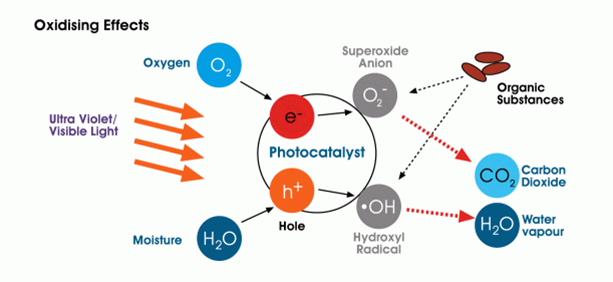
PMITM nano titanium dioxide photocatalyst technology provides a new
generation of environmental purification. The process of air purification
called photocatalysis makes use of light and a photocatalyst to decompose
and neutralize organic matter such as grime, biofilms, bacteria, viruses,
mould VOCs (volatile organic compounds) and odours.
Environmental benefits of photocatalysis include:
- Pollution Control
- Self-cleaning Surfaces
- Odour Elimination
- IAQ Improvement
- Sustainability Enhancement
Catalysis occurs when UV light (from sunlight or fluorescent lights)
energizes titanium dioxide and triggers two chemical reactions that lead
to the near instantaneous formation of hydroxyl radicals (OH*) and
superoxide anions (O2-). These highly reactive chemical agents then
instantly interact at the treated surface to accelerate the
environmentally beneficial decomposition of all organic pollutants.
The OH radical is the most important oxidant in the troposphere, the
lowest part of the atmosphere (below about10 km). Nobel Prize winner Paul
Crutzen coined the phrase “detergent of the atmosphere” to describe this
important cleansing role of OH.
PMI(TM) titanium dioxide photocatalytic solution has been applied in MRT
toilets throughout the North East Line in Singapore to improve sanitation
standard, by killing germs and removing odours. The same technology has
also been implemented in the air-conditioning cooling coils in the Khoo
Teck Puat Hospital and Tan Tock Seng Hospital for air and surface
sterilization and odour removal.
Why Choose PMI Titanium Dioxide (TiO2) Photocatalyst?
PMI Titanium Dioxide Photocatalyst™ has a proven track record around the
world as an environmental cleaning technology. By harnessing the power of
light, PMI cleans the air simply by reacting with pollutants. A tiny layer
of PMI applied on wall surfaces clears the air of carcinogens, biological
organisms (e.g. bacteria, viruses, algae, mould and fungi) and odour
producing chemicals (e.g. ammonia, hydrogen sulphide). PMI also protects
surfaces and inhibits mould and fungal growth. Indoor applications of PMI
include hospitals, cooling coils, toilets, smoking rooms, locker rooms,
canteens and rubbish bin centres.
The self-cleaning property of PMI, combined with its photocatalytic,
pollution consuming abilities makes it an ideal coating for external
building façade under polluting urban conditions. Dirt and grime which
collect on building surfaces are disintegrated by PMI’s photocatalytic
action. Sunshine and rain are all you need to keep external surfaces clean
for extended periods of time.
Application of PMI TiO2 Photocatalyst
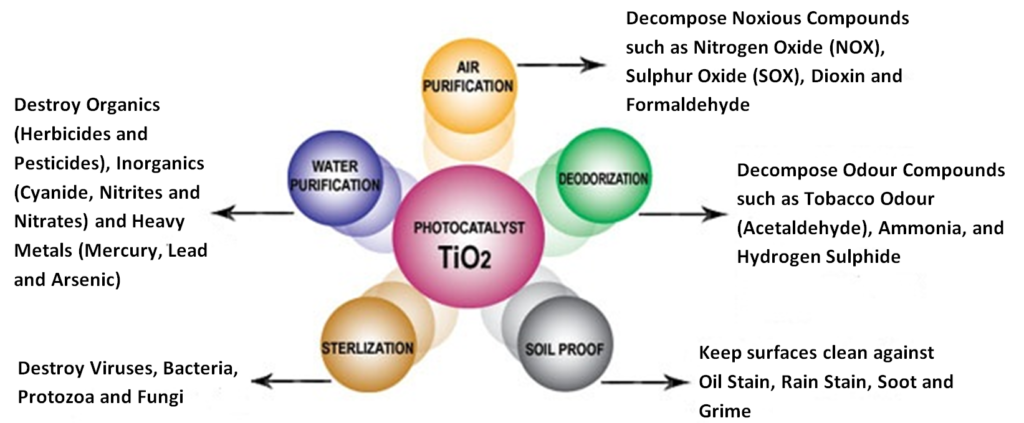

PMI TiO2 Photocatalyst not only kills bacteria, but also decomposes the
cell itself. Hydroxyl radicals generated by TiO2 photocatalyst are very
potent oxidants. When irradiated TiO2 particles are in direct contact
with or close to microbes, the microbial surface is the primary target
of the initial oxidative attack. Polyunsaturated phospholipids are an
integral component of the bacterial cell membrane, and the
susceptibility of these compounds to attack by hydroxyl radicals has
been well documented (Gutteridge JMC. “Lipid Peroxidation: Some Problems
and Concepts”, 1987 & Kappus H. “Lipid Peroxidation: Mchanisms,
Analysis, Enzymology and Biological Relevance”, 1987).
The loss of membrane structure and, therefore membrane functions is the
root cause of microbe cell death when photocatalytic TiO2 particles are
outside the cell. The toxin called endotoxin, produced at the end of cell
death is also destroyed by photocatalytic action. Titanium dioxide does
not deteriorate. It has a long-term anti-bacterial effect.
Deodourizing Effect
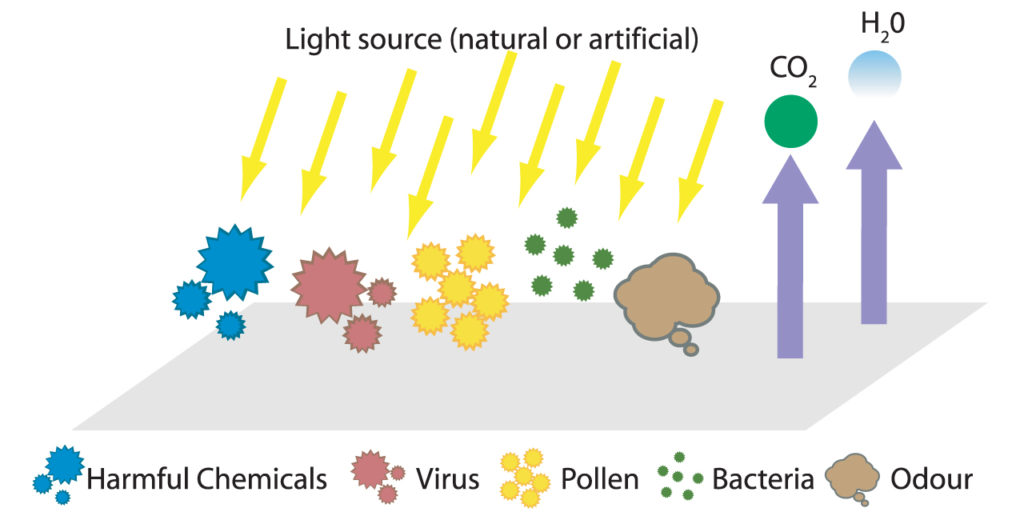
PMI eliminates odours by generating hydroxyl radicals which accelerate
the breakdown of any Volatile Organic Compounds or VOCs by destroying
their molecular bonds. Hydroxyl radicals chop these bonds and cut the
molecule into smaller compounds which are broken over and over until
only carbon dioxide and water are left.
Examples of odour molecules include tobacco odour, garbage odour,
formaldehyde, nitrogen dioxide and many other hydro carbon molecules in
the atmosphere.

The photocatalytic reactivity of PMI can be applied for the reduction or
elimination of many harmful pollutants in the air such as nitrogen and
sulphur oxides, carbon monoxide and benzene (one of many harmful
constituents of cigarette smoke). The by-products of the photocatalytic
reaction vary depending on what substances are involved, but they are
relatively benign. Nitrogen oxides are broken down into nitrates, while
organic compounds are turned into carbon dioxide and water
In polluted urban environment, atmospheric constituents such as
chlorofluorocarbons (CFCs) and CFC substitutes, greenhouse gases, and
nitrogenous and sulfurous compounds are removed when they undergo
photochemical reactions in the presence of sunlight. Paving blocks treated
with TiO2 photocatalyst have been used in cities for such air cleaning
purposes.
Self-Cleaning Effect
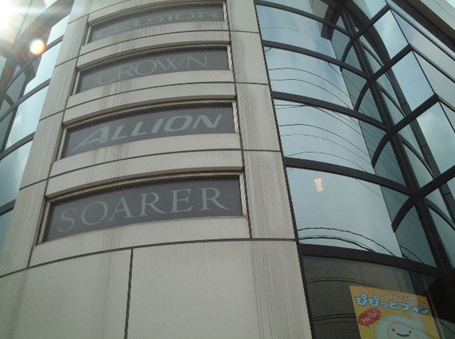
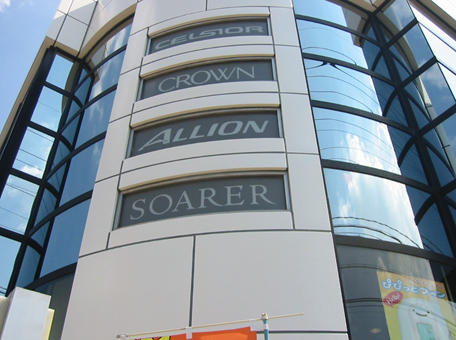
Most of the exterior walls of buildings become soiled from dust, grime and
automotive exhaust fumes which contain oily components. If the building
façade walls are coated with titanium dioxide, a protective film of
photocatalyst on the wall surfaces provides a ‘self-cleaning’ effect.
Sunlight provides the energy to initiate photocatalytic action to
decompose and loosen dirt and grime deposited on the wall surfaces.
PMI TiO2 photocatalyst has an interesting super-hydrophilic property. When
water comes into contact with a surface coated with PMI and irradiated
with sunlight, the contact angle of the droplet of water decreases
dramatically to close to zero degree. The treated surface’s affinity for
water helps to spread rain drops into a thin film under the dirt. Together
with the help of gravity, the dirt just slides down the wall surfaces. The
hydrophilic property of PMI also helps to remove and prevent water marks
and stains from forming on building surfaces since water always appear as
a thin film. The view of the outside from the inside of a building will
also be clearer on a rainy day as optical distortion from water droplets
on a glass window has been eliminated.
Water Purification

PMI TiO2 Photocatalyst coupled with UV lights can oxidize organic
pollutants into nontoxic materials such as CO2 and water and can
destroy microbes and their toxins. Pilot projects have demonstrated
that photocatalytic detoxification systems could effectively kill
faecal coli form bacteria in secondary wastewater treatment.
The combination of sunlight and photocatalyst is a promising option
for water treatment in areas with insufficient infrastructure but high
yearly sunshine. The use of compound parabolic reactors as an
efficient technology to collect and focus diffuse and direct solar
radiation onto a transparent pipe containing contaminated water has
demonstrated feasibility for water disinfection.
Download
Web Site